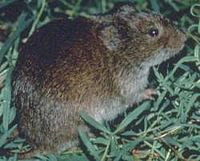
Supplementary food for Neoseiulus californicus boosts biological control of Tetranychus urticae on strawberry.
Sign Up to like & getrecommendations! Published in 2019 at "Pest management science"
DOI: 10.1002/ps.5312
Abstract: BACKGROUND A wide range of supplementary food resources can be offered to generalist predatory mites to improve their survival and reproduction and enhance their persistence in the environment. We investigated the relative suitability of different… read more here.
Keywords: tetranychus urticae; neoseiulus californicus; californicus; supplementary food ... See more keywords

Molecular monitoring of Neoseiulus californicus released from sheltered slow-release sachets for spider mite control in a Japanese pear greenhouse
Sign Up to like & getrecommendations! Published in 2020 at "Experimental and Applied Acarology"
DOI: 10.1007/s10493-019-00463-4
Abstract: A novel system for spider mite control was developed with a slow-release sachet containing Neoseiulus californicus (McGregor) (Acari: Phytoseiidae) protected by a waterproof shelter. Monitoring the efficacy of the predator release system for spider mite… read more here.
Keywords: mite control; californicus; spider mite; release ... See more keywords

Do intraguild prey protect their eggs from intraguild predators that share their oviposition site?
Sign Up to like & getrecommendations! Published in 2018 at "Animal Behaviour"
DOI: 10.1016/j.anbehav.2018.04.005
Abstract: Intraguild (IG)-prey prefer to oviposit at sites with a low IG-predation risk of their offspring. However, IG-predators sometimes show oviposition preferences similar to those of IG-prey. In such cases, IG-prey eggs might need protection against… read more here.
Keywords: californicus; presence; intraguild prey; mite species ... See more keywords

Synergism to acaricides in resistant Neoseiulus californicus (Acari: Phytoseiidae), a predator of Tetranychus urticae (Acari: Tetranychidae)
Sign Up to like & getrecommendations! Published in 2018 at "Crop Protection"
DOI: 10.1016/j.cropro.2017.12.026
Abstract: Abstract Tetranychus urticae Koch is one of the most important phytophagous mite species worldwide, and Neoseiulus californicus (McGregor) is the main predatory mite species marketed for control of this pest in Brazil. The present study… read more here.
Keywords: tetranychus urticae; neoseiulus californicus; californicus; resistance ... See more keywords

Different responses to hypobaria between spider mites and a predatory mite
Sign Up to like & getrecommendations! Published in 2017 at "International Journal of Acarology"
DOI: 10.1080/01647954.2017.1360938
Abstract: ABSTRACT Spider mites are a quarantine pest for different agricultural products imported to Japan, which may require phytosanitary treatments. To develop an environmental-friendly physical method to control agricultural pests, with minimal harm to natural enemies,… read more here.
Keywords: californicus; responses hypobaria; spider mites; different responses ... See more keywords

Biocontrol of Wireworms (Coleoptera: Elateridae) Using Entomopathogenic Nematodes: The Impact of Infected Host Cadaver Application and Soil Characteristics
Sign Up to like & getrecommendations! Published in 2021 at "Environmental Entomology"
DOI: 10.1093/ee/nvab042
Abstract: Abstract Wireworms have become a significant menace to cereals in the Northern Great Plains. Therefore, research toward developing effective control methods such as biological control with entomopathogenic nematodes (EPNs) is warranted. Two strains, each of… read more here.
Keywords: californicus; entomopathogenic nematodes; carpocapsae cxrd; soil ... See more keywords

Biological Features of Neoseiulus californicus (Acari: Phytoseiidae) Feeding on Schizotetranychus oryzae (Acari: Tetranychidae) Kept on Rice Leaves
Sign Up to like & getrecommendations! Published in 2019 at "Journal of Economic Entomology"
DOI: 10.1093/jee/toz138
Abstract: Abstract Schizotetranychus oryzae Rossi de Simons attains pest level in rice crops. This study aimed to evaluate the biological features of Neoseiulus californicus (McGregor) feeding on S. oryzae on leaves of flooded rice. We also… read more here.
Keywords: neoseiulus californicus; californicus; rice; schizotetranychus oryzae ... See more keywords

On the bioconversion of dietary carotenoids to astaxanthin in the marine copepod, Tigriopus californicus
Sign Up to like & getrecommendations! Published in 2018 at "Journal of Plankton Research"
DOI: 10.1093/plankt/fbx072
Abstract: Red carotenoid-based coloration is widely distributed across marine and terrestrial animals and has taken a prominent role in studies of how phenotypic traits evolve in response to natural and sexual selection. Key to these studies… read more here.
Keywords: californicus; coloration; copepod tigriopus; tigriopus californicus ... See more keywords

Demographic analysis of sublethal effects of spiromesifen on Neoseiulus californicus (Acari: Phytoseiidae)
Sign Up to like & getrecommendations! Published in 2017 at "Acarologia"
DOI: 10.24349/acarologia/20174173
Abstract: The sublethal effect of spiromesifen on life table parameters of Neoseiulus californicus McGregor (Acari: Phytoseiidae) was evaluated under laboratory conditions 25±1 °C, 65±5% RH and 16:8 (L:D) h. To take both sexes and the variable… read more here.
Keywords: neoseiulus californicus; californicus; rate; acari phytoseiidae ... See more keywords

Bioactivity of essential oils for the management of Tetranychus urticae Koch and selectivity on its natural enemy Neoseiulus californicus (McGregor): A promising combination for agroecological systems
Sign Up to like & getrecommendations! Published in 2021 at "Acarologia"
DOI: 10.24349/acarologia/20214451
Abstract: The two-spotted spider mite, Tetranychus urticae, causes damage to crops grown in northeast Brazil. The adoption of biological control methods and curative methods (plant-based insecticides) is an essential practice for pest management in agroecological systems.… read more here.
Keywords: tetranychus urticae; agroecological systems; neoseiulus californicus; californicus ... See more keywords